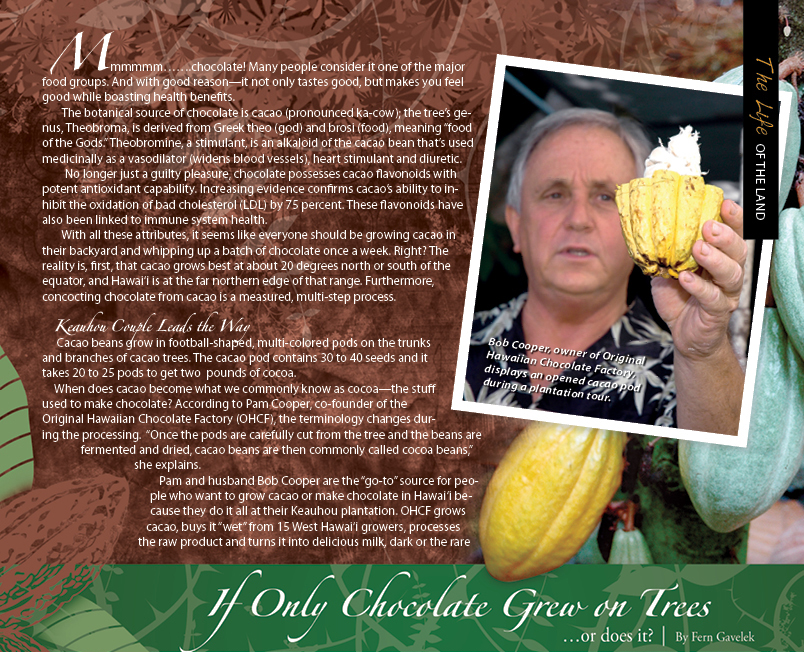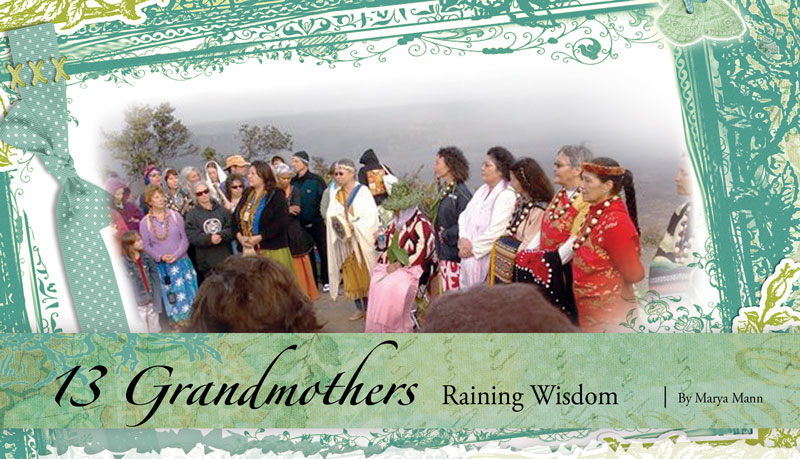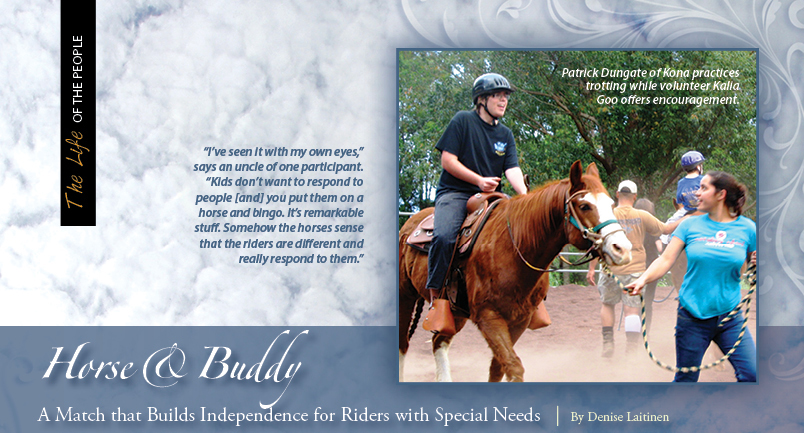
…And Trees Fly Forward: Puna Farmer’s Bhakti Yoga Practice is Immersed in Farming

By Richard Mark Glover
Sankirton Das bucks entanglement with the material world through the practice of farming on five acres in Puna. “It allows me space to funnel consciousness. I chant all day,” he said.
In the afternoon light, Sankirton’s tan torso, the color of a broken-in saddle, is complemented by the black, worn-smooth prayer beads hanging from his neck. “Farming’s not glamorous, but it’s my propensity in this life,” he said. “It doesn’t take a lot of focus to pull weeds,” he said looking out across the short-cut grass of the orchard in Puna near the old, lava-razed railroad hub of Opihikao.
Sankirton’s farm is named Nitai-Gaura’s, a shortening for Nityananda Gauranga, a lord and one of the 108 representatives of Krishna.
His land is now nearly level. “A friend with a D-9 did the hard part. Then I leveled the dips and contours with a pick and shovel. That took about a year,” he smiled. “I brought in 100 loads of biomass from the big county mulcher.” It took three years and five months to bring it from an overgrown, rocky parcel to a lush, fruit-producing farm and Sankirton does the work himself. He grows the fruit organically and uses no irrigation.
“Mulch is important. Keeps the moisture in and really helped the plants to survive the drought we had last winter,” he said. “I’ve done a lot of vegetable gardens, but as my body got older I realized trees were the way to go, less bending.”
Sankirton sells the fruit at the Sea View Farmers Market every Saturday.
“I always have bananas, avocados, lemons and limes. Seasonally, I have oranges, tangerines, temple tangor, soursops, star apples and starfruit,” he said.
Under the roof of his shed, green bunches of bananas hang for market while pots, shovels and soils litter the ground, along with cuttings and starts from other trees he’s experimenting with, including cacao, Brazilian plum, Surinam cherries and a citrus plant from the world of science fiction called Buddha’s Hand. The strange fruits hang heavy on the limbs and their long green fingers seem to grasp at thin air.
Sankirton grew up Paul Manning in Miami Beach, offspring of Jewish parents. With no thought to farming, he surfed and dreamed of far-away ocean breaks. Just after high school his best friend became vegetarian and Sankirton followed suit.
“It had a mellowing effect on me and opened up my spiritual quest,” he said standing in the shade of a lemon tree. “I’d never thought about the karmic reaction of killing an animal to eat.”
Tradewinds fluttered the leaves while a rainbow hung over the sea, its colors thinned by a passing cloud.
“Killing anything has karmic reaction, but yanking a head of lettuce from a plant is much less than slaughtering a cow,” Sankirton said.
Nicknamed “Sunshine,” Sankirton travelled around the Mainland and spent time in Columbia University’s dorms during the student take-over in 1968. He met up with the Weather Underground, Black Panthers and the Yippies in Washington, D.C.; he tripped on acid in Boulder and made Dead concerts in Berkeley before catching a jet for Kaua‘i.
In Hanakāpā‘ai Valley he met up with a yogi.
“There were a lot of us, camping, living off the land, digging life, but I was just beginning to see how the material world can never satisfy the soul,” Sankirton said.
“Even the trees are cleansed when they hear the name of God.”
Now almost 40 years in the spiritual practice of Bhakti Yoga, Das lives a simple life, enjoying the bounty of his farm and aligning himself under the direction of his spiritual master.
“When he accepted me as a disciple about 15 years ago, I became Sankirton Das, a name that means to chant out loud and hear the name of God. It’s powerful and allows me to link up with the Supreme Being,” he said. “Even the trees are cleansed when they hear the name of God.”
Nestled between coconut palms, citrus and banana trees, Sankirton’s solar-powered, one-room house is decorated with images of Krishna. Prints of the beautiful boy with the intense stare and the multi-pawed lion hang life-like in the corners. Incense censers and books like the Bhagavad Gita, Krishna Krishna and The Golden Avatar lie on open shelves. He walks across the purple plywood floor and squeezes juice from a pink Eureka lemon, then adds water and raw honey.
“I’m not interested in religion,” he said as the Maha Mantra played in the background. “It might lead to spirituality and it might not. Jesus did not teach Christianity. He simple delivered ultimate truth and taught in accord with the time and place and people’s consciousness.”
Sankirton believes an epoch passed many eons ago when people were more God-conscious and more loving toward each other. He describes the present state on earth as “down a notch in consciousness” and “short-fused, short-memoried and short-lived,” beset by “chaos, quarrel and confusion.”
“There is refuge in the platform of God’s pure love,” he said as he carefully folded his knees on the floor. “I am self-sufficient only through the Supreme Being’s will. I can’t grow a tree, but God can.”
But tending God’s garden on the wet side of Hawai‘i Island may be risky business.
“It’s the worst job in Puna,” he said. “I’m constantly pulling weeds and constantly coming into contact with the slugs,” he stretched his body and winced.
One year ago, Sankirton contracted rat lung disease, scientifically known as Angiostrongylus Cantonensis. According to the Centers for Disease Control and Prevention (CDC), it is a disease generated by a parasitic worm found in the pulmonary arteries of rats. Virulent and destructive to humans, the parasite evolves to the infective stage as it matures in the digestive system of slugs and snails that have eaten rodent feces. Parmarion Martensi, a tiny slug from South East Asia and a new arrival to Hawai‘i, has shown in a recent study to be infected with the parasite 77 percent of the time. Infected slug slime found on fruit, vegetables or the hands, if ingested, can be life-changing.
“I had a spinal tap.” His thin lips quivered. “It travels in the spinal fluids and eventually works its way into the central nervous system,” he said.”They’re not sure what to do with it, gave me a lot of drugs. I spent four months in the hospital and I’m just now recovering my strength, but the pain has not gone away.”
According to the CDC, the disease, a form of meningitis, was first identified in Taiwan in 1944. Recent outbreaks have also been reported in New Orleans, Kingston, and Kaohsiung.
“I’m an eternal soul. I don’t know where I’m picking up from—somewhere down the line, I don’t know—I don’t know why, but there’s no coincidences,” he rubbed a bead on his necklace. “I’m not a raw foodist. But please, wash all your fruit and vegetables.”
He walked between the rows of avocado and starfruit planted just outside the shade of the banana trees that line the perimeter of his farm.
“Sometimes when I’m digging and I see an earthworm, I think, ‘child of God.’ Life like that—the soul much more covered up, the consciousness not developed—it’s still in process, one of the 8.4 million forms of material life that the soul can transmigrate through. The human form is rare—we should cherish it. And trees…” he looked across the grassy slope toward the citrus. “Trees fly forward.”
Photos by Richard Mark Glover


